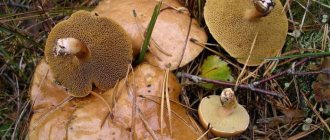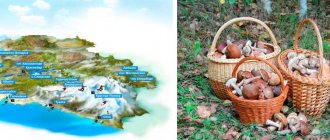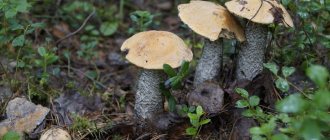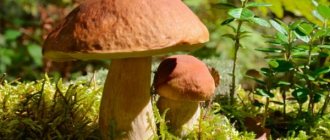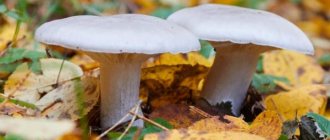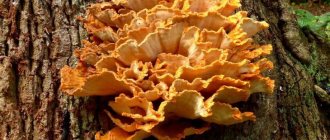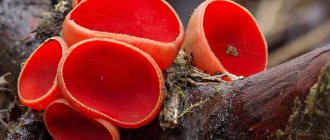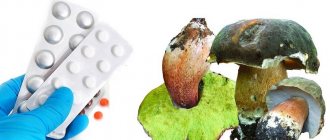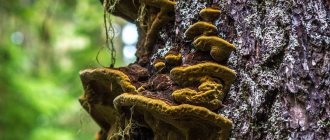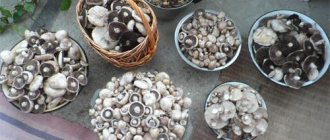The Urals are a huge territory of Russia with magnificent nature and large forests, in which there are many valuable mushrooms, berries and other plants. Every year local residents harvest rich harvests. More than one agricultural company has been created here, so edible mushrooms of the Urals are sold in many regions in salted, pickled, frozen and dried form.
General characteristics
In the Urals, the campaign to collect forest resources continues almost all year round.
This region is considered one of the most promising for the development of mushroom production. Crowds of local residents, starting in early spring, head to the taiga for a tasty harvest, which is then salted, fermented, fried and steamed sparing no effort.
Mushrooms are a storehouse of microelements and vitamins. By eating them regularly, you will be able to get rid of many diseases, stimulate the immune system and normalize cholesterol levels in the blood.
All mushrooms used have a general classification and are divided into the following categories (groups):
- Category 1: edible;
- Category 2: conditionally edible;
- Category 3: inedible;
- Category 4: poisonous.
The presence of toxins determines the degree of edibility. Not only the first group is allowed to eat. Inedible and conditionally edible varieties are also used in cooking. Before the main cooking, additional processing, soaking and cooking are carried out. Poisonous mushrooms should not be eaten. It is difficult to remove toxins at home; it is better not to risk life and health.
Edible forest mushrooms of Siberia, the Urals and other regions are divided into flavor categories:
- Category 1: the most fragrant;
- Category 2: less aromatic and average taste;
- Category 3: with weak aroma and taste.
Boletus, boletus, boletus and boletus belong to the first, most aromatic and tasty category. Its representatives are used primarily by culinary specialists, using a variety of processing methods. Even in dry form, white ones do not lose their properties and remain just as tasty.
Ryzhiki, autumn honey mushrooms and russula have average taste and aroma. They are often boiled and fried.
The third taste category includes conditionally edible and inedible species.
They take longer to cook. All kinds of spices are added to give them flavor. They are used to create pates and pickling. They are pre-soaked to remove the unpleasant bitter taste of the milky juice that is present in the pulp.
Areas of application
Mushrooms are an amazing product. They are high in protein and amino acids, which means they are an excellent alternative to meat.
- Regular consumption of them reduces the risk of cancer.
- Due to their rich composition, they have a beneficial effect on the nervous and hematopoietic systems, as well as blood vessels.
- Vitamin B in fruiting bodies is much higher than in some vegetables and grains.
In addition, mushrooms are actively used for testing and developing new medical products, for the production of paper and cardboard, as well as in the field of cosmetology and animal husbandry.
Edible species
In the Urals, mushrooms are found everywhere and during any season. But not all of them are edible. To avoid mistakes, it is better to get acquainted with edible species in advance. The most popular in this region include the following:
- White;
- Boletuses;
- Boletus mushrooms;
- Butter;
- Saffron milk caps;
- Volnushki;
- Russula;
- Squeakers;
- Milk mushrooms;
- Rogatiki.
Summer and autumn honey mushrooms are so common that some people pass by, considering them something like weeds.
White
The white mushroom is called the king of the forest
The porcini mushroom cannot be confused with others; it is memorable at first sight. He is called the "king of the forest." In the Urals they came up with other names for it:
It has a beautiful powerful stem, cylindrical at the bottom and tapering towards the cap. Her color is white. The surface of the cap is brown, sometimes slightly reddish. The pulp is dense, with a strong mushroom aroma. At the bottom of the cap there is a spongy layer of white or slightly yellowish color. The color never changes when cut. Even when dry, the pulp remains snow-white. This is an important quality of the mushroom. This is why the mushroom was nicknamed “white”.
Whites grow in mixed forests from early July to October. They prefer dry, non-boggy soils.
Boletus
The boletus has a second name - redhead, which it received among the people because of the color of its cap. And also - aspen, kvasyuk, obabok, goose. The lower (spore-bearing) layer of its cap becomes brown with age. The shape of the leg is cylindrical, reaching a height of 18 cm. A mesh consisting of dark scales is clearly visible on it.
A characteristic feature is the blue discoloration of the cut. The aroma is strong and pleasant. The pulp is dense, homogeneous, soft. Boletuses grow in deciduous and mixed forests under aspens and other deciduous trees. The best collection time is from July to the end of September.
boletus
If an aspen boletus is found in the forest, then there will definitely be a boletus somewhere nearby. These forest organisms form mycorrhizae with birch, poplar, and aspen trees. Mass collection begins in June and continues until the end of August.
- the cap is dense and wide;
- cap diameter – up to 30 cm (maximum);
- cap color dark brown;
- the leg is slender, dense, uniform;
- the color of the leg is grayish and beige;
- height – up to 25 cm;
- the flesh is white;
- The aroma is pleasant and strong.
The pulp has a uniform structure. The cut never gets dark. When heat treated it becomes dark. For this reason, the boletus is called “black”.
Rogatiki
Scallops, or horned scallops, are a real gourmet delicacy.
Experienced mushroom pickers will never pass by these strange-looking mushrooms. Mushroom spots sometimes do not change for many years due to the “perseverance” of the mycelium. Rogatiki are highly valued by chefs not only of the southern Urals, who use them to prepare delicacies, but also of other regions. It is the delicate aroma and pleasant taste that give dishes their uniqueness. Only young specimens that have white-pink flesh are taken. The shape of the mushroom resembles a branched sea coral with small horns, hence the name. Those who are unfamiliar with the cattail often pass by, considering it inedible.
Irina Selyutina (Biologist):
In addition to the above-mentioned mushrooms and milk mushrooms, they are loved in the Urals. To collect them you need to know where best to look for them. An experienced mushroom picker will never go to young forests where the height of the tree is no higher than the height of a person. He will pay attention to older landings. And in old forests - rest assured, you will definitely meet your desired prey - milk mushrooms. It often happens that the fruiting bodies are hidden almost completely up to the cap in the ground. Then sticks come to the rescue, with which you can “pick” at suspicious tubercles. But some particularly “thoughtful” mushroom pickers perform this operation with specially grabbed small rakes. To find milk spots, you need not only experience, but also a “smell” for them. As it turned out, milk mushrooms have a characteristic smell that can never be confused with anything else. Its source is the fruiting bodies and mycelium of the fungus.
When going mushroom hunting, it is important to pay attention to the smallest details, because they are what help you find mushrooms and return home with a basket full of wonderful gifts from the forest.
Mushrooms of Siberia - where to go for the harvest
Every season, lovers of quiet hunting go into the forest in search of nature's gifts. Mushrooms of Siberia are distinguished by a fairly early fruiting period - they can be found starting in spring. They won their audience thanks to their excellent taste characteristics and considerable content of useful substances, incl. amino acids. All types are suitable both for winter preparations and for preparing a variety of dishes. But to prevent the collection from turning into a tragedy, it is necessary to have a good understanding of edible and poisonous varieties.
Mushrooms of Siberia - where to go for the harvest
Poisonous species
Poisonous mushrooms should not be collected
Avid mushroom pickers are familiar with poisonous species and will not put them in the basket. They know the species that are on the black list. But sometimes even the most professional assemblers make mistakes. Before going into the forest, it is better to remember what poisonous and inedible mushrooms are found in the Urals. The most famous and frequently encountered include the following:
- false scent;
- Satanic;
- gall;
- death cap;
- red fly agaric;
- yellow-skinned champignon;
- false fox.
Death cap
This not very large and simple-looking fungus is dangerous. Its toxins are so strong that they can even penetrate the skin. Therefore, mushroom pickers do not touch the toadstool and leave it to grow in its place. One touch of it to completely edible mushrooms will make them poisonous.
According to the description, it looks like russula or honey fungus, but there is no “skirt” on the leg. Her hat is whitish or brown-olive. There is almost no smell, completely tasteless. It grows in birch groves from June until frost.
fly agaric
Among the poisonous ones, fly agaric is especially dangerous. Rare giant individuals are found in these forests, especially after good rains. It is after rains that fly agarics can easily be confused with russulas, because the white spots on their caps are washed away by water and they become almost invisible.
- the leg is tall and slender;
- the color of the leg is white (or yellowish);
- grow in height up to 23-30 cm;
- the cap is smooth, lamellar;
- the surface of the cap has a reddish color;
- there is a characteristic thin “skirt” under the hat;
- cap size – up to 30 cm.
Where to collect saffron milk caps in the Sverdlovsk region
Experts have divided the Sverdlovsk region into 3 conventional mushroom zones:
- In the mountainous area in the western part of the Ivdel region there are dry forests, in which, in addition to saffron milk caps, there are boletus, chanterelles and honey mushrooms.
- The wettest forests richest in mushrooms are located in the swampy area: the eastern part of the Ivdelsky district, as well as the Serovsky, Taborinsky, Garinsky and Novolyalinsky districts.
- In the forest-steppe zones there are mixed, as well as birch forests and copses. However, here mushrooms are collected only after heavy rains. The forest-steppe zone covers several districts: Achitsky, Artinsky, Nizhneserginsky, Kamensky, Kamyshlovsky, Tugulymsky and Bogdanovichevsky.
The climatic weather conditions of the region are very favorable for the growth of many types of fruiting bodies. In the forests you can collect a rich harvest of mushrooms and provide yourself and your family with supplies for the whole winter. For example, saffron milk caps are also collected in the vicinity of Yekaterinburg. Leaving the city in any direction, you can get into the forest and not only take a break from the bustle of the city, but also quietly “hunt.” The main thing is to get away from highways and roadside dumps.
List of forest edible mushrooms with photos and tips for novice mushroom pickers
Mushrooms are considered edible; they can be used as food with absolutely no risk to life and health, since they have significant gastronomic value, are distinguished by a delicate and unique taste; dishes made from them do not become boring and are always in demand and popularity.
Good mushrooms are called lamellar, on the underside of the caps there are lamellar structures or spongy, since their caps on the underside resemble a sponge, inside of which there are spores.
When picking, experienced mushroom pickers always pay attention to special signs that a mushroom is edible:
- frequency of the plates;
- what color are the spores;
- how the plates are attached to the leg;
- change in color of the pulp when pressing on it.
Forest mushrooms grow from a mycelium that resembles a grayish light mold that appears on a rotting tree. Delicate fibers of the mycelium intertwine the roots of the tree, creating a mutually beneficial symbiosis: the mushrooms receive organic matter from the tree, and the tree receives mineral nutrients and moisture from the mycelium. Other types of mushrooms are tied to tree species, which later determined their names.
The list contains wild mushrooms with photos and their names:
- boletus;
- registry;
- boletus;
- subdukovik;
- pine mushroom;
- speckled oak or common oak, others.
In coniferous and mixed forests there are many other mushrooms that mushroom pickers are happy to find:
During harvesting, it is best to place mushrooms in special wicker baskets, where they can be ventilated; in such a container it is easier for them to retain their shape. You cannot collect mushrooms in bags, otherwise, after returning home, you may find a sticky, shapeless mass.
It is allowed to collect only those mushrooms that are definitely known to be edible and young; old and wormy ones should be thrown away. It is better not to touch suspicious mushrooms at all and avoid them.
The best time to collect is early in the morning, while the mushrooms are strong and fresh, they will last longer.
Mushroom places + map
Mushroom pickers are offered three zones to search for edible mushrooms: forests with dry soil, damp soil and forest-steppe, more than several kilometers long.
Dry soil in 2022 is typical for 7 places:
- Severouralsk region;
- Nizhny Tagil;
- Tugulym;
- the outskirts of the Alapaevsky district;
- Verkhoturye district;
- Yekaterinburg;
- Beloyarsk district.
The forest-steppe forests located in the eastern and southern parts of the Sverdlovsk region are praised for their abundance of mushrooms. A particularly rich harvest fell on the Pyshminsky, Kamensky and Krasnoufimsky districts.
The remaining areas are part of mixed forests, wide fields and mountain ranges. You can find mushrooms there from the beginning of spring until late autumn, if you have the desire and strength to search.
If you believe the coordinates left by many amateur mushroom pickers, in 2022 you can find a lot of mushrooms if you go into the forest by car or train to Ilmovka or the village of Druzhinino.
The northern side of Dvurechensk and the Tugulym region became a treasure trove of honey mushrooms and saffron milk caps.
In the Verkhoturye region there are many boletus and butter mushrooms.
Wetlands are also on the list, although it is not safe to look for mushrooms there. On the way there may be snakes, swamps and peat soil, which can, if not drag a person down, then “steal” shoes.
Characteristics of edible mushrooms and their description
Among the noble representatives of edible, tasty and healthy mushrooms, there is a special group, which is usually characterized by one word “toadstools”, because they are all poisonous or deadly poisonous, there are about 30 species. They are dangerous because they usually grow next to edible ones and often look similar to them. Unfortunately, only a few hours later it turns out that a dangerous mushroom was eaten, when the person was poisoned and ended up in the hospital.
To avoid such serious troubles, it would be useful to look again at the photos, names and descriptions of edible forest mushrooms before going on a “quiet hunt”.
You can start with the first category, which includes the most noble, high-quality mushrooms with the highest taste and nutritional qualities.
Porcini mushroom (or boletus) - it is given the palm, it is one of the rarest among its relatives, the beneficial properties of this mushroom are unique, and the taste is the highest. When the mushroom is small, it has a very light cap on top, which changes its color to yellowish-brown or chestnut with age. The underside is tubular, white or yellowish, the flesh is dense, the older the mushroom becomes, the more flabby its flesh becomes, but its color does not change when cut. This is important to know, since the poisonous gall mushroom is similar in appearance to the white one, but the surface of the spongy layer is pink, and the flesh turns red at the break. In young boletus, the legs have the shape of a drop or a barrel, with age it changes to cylindrical.
It is most often found in summer, does not grow in groups, and can be found in sandy or grassy meadows.
Boletus is a delicious mushroom, rich in microelements, known as an absorbent that binds and removes harmful toxic substances from the human body. The cap of the boletus is a muted brown shade, convex, reaching a diameter of 12 cm, the stem is covered with small scales, and widened towards the base. The pulp does not have a specific mushroom smell; when broken, it acquires a pinkish tint.
Mushrooms love moist soil, you should go for them in a birch grove after a good rain, you need to look right at the roots of birch trees, they are found in aspen forests.
Camelina is a mushroom that got its name due to its special carrot-red color, the cap is an interesting funnel-shaped, with a depression in the middle, circles are visible from the depression to the edges, the lower part and the stem are also orange, the plastics turn green when pressed. The pulp is also bright orange, gives off a light resinous aroma and taste, the milky juice released at the break turns green, then turns brown. The taste of the mushroom is highly valued.
Prefers to grow in pine forests on sandy soils.
The real milk mushroom is considered and called “the king of mushrooms” by mushroom pickers, although it cannot boast that it is suitable for use in various processing: basically, it is eaten only in salted form. The cap at a young age is flat-convex, with a slight depression, turning into a funnel-shaped, yellowish or greenish-white with age. It has transparent, glassy-like diametric circles - one of the characteristic signs of milk mushrooms. The plates from the stem extend to the edge of the cap, on which a fibrous fringe grows. The white, brittle pulp has a recognizable mushroom smell; the white juice, as it weathers, begins to turn yellow.
Next, we can continue to consider the description of edible mushrooms belonging to the second category, which may be tasty and desirable, but their nutritional value is somewhat lower; experienced mushroom pickers do not ignore them.
Oiler is a genus of tubular mushrooms, it got its name because of its oily cap, initially red-brown, then turning into yellow-ocher, semicircular with a tubercle in the center. The pulp is juicy, yellowish in color, without changing when cut.
Boletus (aspen) - while young, the cap is spherical, after a couple of days its shape resembles a plate on a stocky leg elongated to 15 cm, covered with black scales. A cut of the flesh turns from white to pink-violet or gray-violet.
Skripun
Or a violin . This mushroom got its name from the very squeaking noise that occurs when you rub the cap against the cap of freshly picked mushrooms. Few hunters take them into the basket; they do not want to interfere with other mushrooms. But in vain. This mushroom is not at all as bad as they think it is. The creaking goes mainly to salting. First, the mushroom must be thoroughly boiled in two waters.
Well, recognizing a violin among its relatives is as easy as shelling pears: break off a piece of the cap and immediately milky juice, white as milk, will appear in large drops. If you touch it lightly with the tip of your tongue, it will burn with bitterness.
Expanded list of edible mushrooms with photos
This slideshow contains all the mushrooms, including those not mentioned in the article:
EDIBLE MUSHROOMS AND THEIR DANGEROUS DOUBLES
August is the most mushroom month of summer. At this time, you can collect white boletus, boletus, and boletus. We tell you how to distinguish them from “toadstools”.
Cut to basket:
Porcini mushroom - thick and dense stem, brown cap, white flesh. There is a light mesh throughout the entire leg.
Where to look: Artinsky, Kamensky, Sukholozhsky, Krasnoufimsky districts
Let's go around:
Gall mushroom - when cut, the flesh turns pink, the stem is covered with a dark mesh, the taste is bitter.
Gall mushroom. Photo: nashzeleniymir.ru
Cut to basket:
The aspen boletus has a brown-red cap, the flesh turns blue at the break.
Where to look: found everywhere, growing under aspen trees.
Let's go around:
gall mushroom is mistaken for boletus , which is not suitable for food due to its bitter taste. It's simple: if you see something similar to boletus growing not under an aspen, then it is not aspen boletus.
Gall mushroom. Photo: udec.ru
Cut to basket:
Boletus - the color of the cap ranges from white to dark gray and almost black, it can also be brownish on top and white below, the flesh at the break is white, the leg is white with longitudinal white and dark scales, thickens towards the bottom.
Where to look: grows wherever there are birch trees.
Let's go around:
If you see a boletus but there is no birch tree nearby, most likely you have come across a gall fungus. Don't cut it or eat it.
Cut to basket:
Butter - a yellow leg, a yellow cap with a sticky, oily skin on top, which can be easily removed with a knife.
Where to look: Alapaevsky, Sukholozhsky, Krasnoufimsky districts
Butter. Photo: nashzeleniymir.ru
Let's go around:
Pepper mushroom - the brown cap is smooth to the touch, slightly sticky, and shiny in dry weather. The skin cannot be removed from it. Reddish-cherry shade of the stem.
Pepper mushroom. Photo: ru.wikipedia.org
Cut to basket:
Moss fly - reddish-velvet or dark green cap, yellow stem.
Where to look: They often grow in moss, which is how it gets its name.
Moss fly. Photo: moy-ural.ru
Let's go around:
Parasitic flywheel - cap diameter up to 5 centimeters, grows on false raincoats
Parasitic moth fly. Photo: gribnikoff.ru
Cut to basket:
Chanterelles have a bright yellow cap, stem and plates, the flesh is dense and unbreakable.
Where to look: Alapaevsky, Sukholozhsky, Krasnoufimsky districts
Let's go around:
False chanterelle has a reddish-orange or orange-yellow cap; when the cap is broken, white juice is released.
False fox. Photo: travelask.ru
Cut to basket:
Honey mushrooms grow in groups on stumps, trunks of dead trees and roots. The cap is covered with black scales. Under the cap are white, creamy plates. There is a white ring on the leg.
Where to look: Pervouralsk and surroundings
Let's go around:
False honey mushrooms - grow next to ordinary honey mushrooms, but there is no ring on the stem, the cap is yellow or reddish, without scales, the plates are brown, green or black.
Cut to basket:
Saffron milk caps are a reddish lamellar mushroom that secretes orange juice.
Where to look: Sysertsky, Krasnoufimsky, Kamensky, Artinsky, Alalaevsky and Sukholozhsky districts. They can also be found near the Pervouralsky tract.
Ryzhik. Photo: ru.wikipedia.org
Let's go around:
Camelina can be confused with the inedible gray-pink milkweed, which has a very unpleasant, pungent odor.
Milky gray-pink. Photo: ru.wikipedia.org
Cut to basket:
Milk mushrooms are a white mushroom with fluffy edges. Grows in groups next to birch trees.
Where to look: Krasnoufimsky and Sysertsky districts
Milk mushroom. Photo: agroflora.ru
Let's go around:
Pepper milk mushrooms are creamy white, dry, funnel-shaped caps without a tucked edge along the edge. They are distinguished by the abundant secretion of juice that turns olive green or bluish in color.
Where you should not pick mushrooms in the Sverdlovsk region
The following map fully reveals all the ecological ins and outs of our region.
Chemically contaminated areas
First, let's look at the places where all kinds of chemicals are released into the air and rivers. I’ll start with the enterprise closest to me, located exactly on the outskirts of my provincial town. This is the legendary SUMZ, thanks to which the word “sumzik” came into use, meaning a mushroom that grew in an ecologically unfavorable forest and contains a vigorous mixture of chemical additives.
A little further from SUMZ stand the Pervoural giants - “Khrompik” (chemistry) and “Novotrubny” (ferrous metallurgy). The first has already been repeatedly featured in the media for dumping reagents into Chusovaya, and the second recently acquired a steel mill, which, according to the developers, is pristinely clean in terms of emissions into the atmosphere.
So it turns out that mushrooms cannot be collected in most of the territories of the Revdinsky and Pervouralsky districts, as well as around Yekaterinburg - within a radius of at least fifty kilometers, because the latter is stuffed with pollutants. Artyomovsky, Asbest and Sukhoi Log are a continuation of this zone to the east. There, too, there are industrial enterprises that have been polluting the environment for decades. In the area of Nevyansk, Nizhny Tagil, Krasnouralsk and all the way to Nizhnyaya Tura, through Lesnoy and Kachkanar - the same rubbish. Then there seems to be a clear section, but it is treacherously interrupted at the border with Serov, Karpinsk and Krasnoturinsk.
Interesting read: How to distinguish edible mushrooms from inedible ones
Areas with radiation contamination
These are the places that are marked on the map in poisonous green. The first thing you can notice are two small circles near Krasnoufimsk and Rezha. Radioactive materials are stored there. Then we see a large circle around Zarechny - this is the “protection zone” of the Beloyarsk Nuclear Power Plant. In those parts, by the way, the radiation zone intersects with the chemical zone. And therefore, there is double contamination, and the mushrooms probably have a particularly piquant taste. These areas are:
- Kamensky district;
- Bogdanovichsky district;
- Kamyshlovsky, Pyshminsky;
- border region between Baikalovsky and Talitsky;
- Slobodo-Turinsky and Tugulymsky districts.
